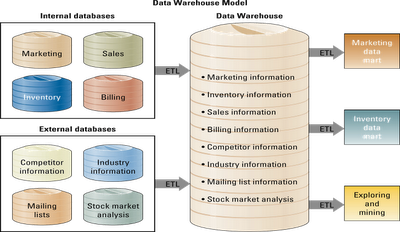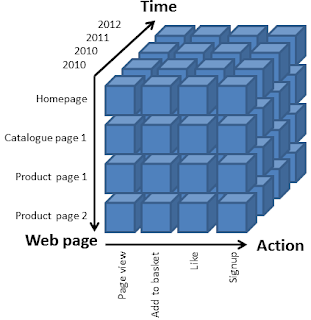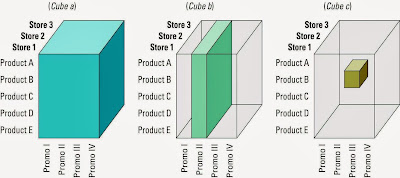Bila tiada, disuruh cari,
Sudah dicari, menolak pula,
Belum masa untuk menerima,
Hati sendiri pun susah nak dikata..
Sedar diri banyak kekurangan,
khuatir kelak jadi derhaka,
Bukan mudah untuk memulakan,
Kerana hati payah menerima....
anysbalkis
calculatorhati.blogspot.com
Wednesday, 13 August 2014
Monday, 10 March 2014
CHAPTER 12 : INTEGRATING THE ORGANIZATION FROM END TO END-ENTERPRISE RESOURCE PLANNING (ERP)
Enterprise resource planning systems serve as the organization's backbone in providing fundamental decision-making support.
The heart of an ERP system is a central database that collects information from and feeds information into all the ERP system's individual application components (called modules), supporting diverse business functions such as accounting, manufacturing, marketing, and human resources.
ERP Integration Data Flow
ERP PROCESS FLOW
THE EVOLUTION OF ERP
ERP
ERP
- materials planning
- order entry
- distribution
- general ledger
- accounting
- shop floor control
ENTENDED ERP
- scheduling
- forecasting
- capacity planning
- ecommerce
- warehousing
- logistics
ERP-II
- project management
- knowledge management
- workflow management
- customer relationship management
- human resource management
- portal capability
- integrated financial
INTEGRATING SCM, CRM, AND ERP
= backbone of e-business
= backbone of e-business
=Integration allows the unlocking of information to make it available to any user, anywhere, anytime.
INTEGRATION TOOLS
middleware :
= several different types of software that sit in the middle of ans provide connectivity between two or more software applications.
= several different types of software that sit in the middle of ans provide connectivity between two or more software applications.
= middleware translates information between disparate systems.
enterprise application integration (EAI) middleware:
= represents a new approach to middleware by packaging together commonly used functinally, such as providing prebuilt links to popular enterprise applications.
= represents a new approach to middleware by packaging together commonly used functinally, such as providing prebuilt links to popular enterprise applications.
PRIMARY USERS AND BUSINESS BENEFITS OF STRATEGIC INITIATIVES
INTEGRATIONS BETWEEN SCM, CRM, AND ERP APPLICATIONS
CHAPTER 11 : Building a Customer-centric Organization-CRM
Customer relationship management (CRM) is a means of managing all aspects of a customer's relationship with an organization to increase customer loyalty and retention and an organization's profitability.
To guarantee that every customer has a highly satisfying online buying experience, the company asks the dealers to agree to a number of standards including:
- Checking online orders twice daily
- Shipping online orders within 24 hours
- Responding to customer inquiries within 24 hours
A primary component of managing a customer relationship is knowing when and why the customer is communicating with the company.
THE BENEFITS OF CRM
-Enables a firm to treat customers as individuals, gaining important insights into their buying preferences and shopping behaviors.
-Enables a firm to treat customers as individuals, gaining important insights into their buying preferences and shopping behaviors.
Firms can find their most valuable customers by using the RFM formula-recency, frequency, and monetary value.
- How recently customer purchased items
- How frequently a customer purchases items
- The monetary value of each customer purchase
Sunday, 9 March 2014
CHAPTER 10 : EXTENDING THE ORGANIZATION-SUPPLY CHAIN MANAGEMENT
BASICS OF SUPPLY CHAIN
A supply chain:
=consists of all parties involved, directly or indirectly, in the procurement of a product or raw material.
Supply Chain Management (SCM):
=involves the management of information flows between and among stages in a supply chain to maximize total supply chain effectiveness and profitability.
3 main links of supply chain :
A supply chain:
=consists of all parties involved, directly or indirectly, in the procurement of a product or raw material.
Supply Chain Management (SCM):
=involves the management of information flows between and among stages in a supply chain to maximize total supply chain effectiveness and profitability.
3 main links of supply chain :
- Materials flow from suppliers and their upstream suppliers at all levels.
- Transformation of materials into semi finished and finished products, or the organization's own production processes.
- Distribution of products to customers and their downstream customers at all levels.
A TYPICAL SUPPLY CHAIN
5 Basic Supply Chain Management Activities:
Supply Chain Management Success Factors
There are three (3) :
Seven Principles of Supply Chain Management
Keys to SCM success :
- PLAN = prepare to manage all resources required to meet demand.
- SOURCE = build relationships with suppliers to procure raw materials.
- MAKE = Manufacture products and create production schedules.
- DELIVER = plan for transportation of goods to customers.
- RETURN = support customers and product returns.
INFORMATION TECHNOLOGY'S ROLE IN THE SUPPLY CHAIN
Information technology's primary role in SCM is creating the integrations or tight process and information linkages between functions within a firm.
THE INTEGRATED SUPPLY CHAIN
Factors driving supply chain management :
- VISIBILITY
= the ability to view all areas up and down the supply chain.
= bullwhip effect occurs when distorted product demand information passes from one entity to the next throughout the supply chain. - CONSUMER BEHAVIOR
= Demand planning software generates demand forecasts using statistical tools and forecasting techniques. - COMPETITION
= Supply chain management software can be broken down into
(1) supply chain planning software
(2) supply chain execution software
both increase a company's ability to compete.
= Supply chain planning (SCP) software uses advanced mathematical algorithms to improve the flow and efficiency of the supply chain while reducing inventory.
= Supply chain execution (SCE) software automates the different steps and stages of the supply chain. - SPEED
= A company is able to satisfy continually changing customer requirements efficiently, accurately, and quickly.
Supply Chain Management Success Factors
There are three (3) :
Seven Principles of Supply Chain Management
Keys to SCM success :
- Make the sale to suppliers
- Wean employees off traditional business practices
- Ensure the SCM system supports the organizational goals
- Deploy in incremental phases and measure and communicate success
- Be future oriented
Monday, 10 February 2014
CHAPTER 9 : ENABLING THE ORGANIZATION-Decision Making
MAKING BUSINESS DECISION
THE DECISION-MAKING PROCESS
The process of making decisions plays a crucial role in communication and leadership for operational, managerial, and strategic projects.
THE SIX-STEP DECISION MAKING PROCESS
- Problem identification : Define the problem as clearly and precisely as possible.
- Data collection : Gather problem-related data, including who,what,where,when,why, and how. Be sure to gather facts, not rumors or opinions about the problem.
- Solution generation : Detail every solution possible, including ideas that seem farfetched.
- Solution test : Evaluate solutions in terms of feasibility (can it be completed?), suitability (is it a permanent or a temporary fix?), and acceptability (can all participants form a consensus?).
- Solution selection : Select the solution that best solves the problem and meets the needs of the business.
- Solution Implementation : If the solution solves the problem, then the decisions made were correct. If not, then the decision were incorrect and the process begins again.
DECISION-MAKING ESSENTIALS
- A few key concepts about organizational structure will help our discussion of MIS decision-making tools.
- The structure of a typical organization is similar to a pyramid, and the different levels require different types of information to assist in decision making, problem solving, and opportunity capturing.
Operational
- At the operational level, employees develop, control, and maintain core business activities required to run the day-to-day operations.
- Operational decisions are considered structured decisions, which arise in situations where established processes offer potential solutions.
Managerial
- Emloyees are continuously evaluating company operations to hone the firm's abilities to identify, adapt to, and leverage change.
- these types of decision are considered semistructured decisions-occur in situations in which a few established processes help to evaluate potential solutions, but not enough to lead to a definite recommended decision.
Strategic
- Managers develop overall business strategies, goals, and objectives as part of the company's strategic plan.
- strategic decisions are highly unstructured decisions- occuring in situations which no procedures or rules exist to guide decision makers toward the correct choices.
ENHANCING DECISION MAKING WITH MIS
- A model is a simplified representation or abstraction of reality.
OPERATIONAL SUPPORT SYSTEMS
- Transactional information encompasses all the information contained within a single business process or unit of work.
- Its primary purpose is to support the performance of daily operational or structured decisions.
Online transaction processing (OLTP) is the capture of transaction and event information using technology to:
- process the information according to defined business rules.
- store the information.
- update existing information to reflect the new information.
A transaction processing system (TPS) is the basic business system that serves the operational level (analysts) and assists in making structured decisions.
MANAGERIAL SUPPORT SYSTEMS
Analytical information encompasses all organizational information.Its primary purpose is to support the performance of managerial analysis or semistructured decisions. Analytical information includes transactional information along with other information such as market and industry information.
Online analytical processing (OLAP) is the manipulation of information to create business intelligence in support of strategic decision making.
Decision support systems (DSSs)
- model information using OLAP, which provides assistance in evaluating and choosing among different courses of action.
- DSSs enable high-level managers to examine and manipulate large amounts of detailed data from different internal and external sources.
What-if analysis
What-if analysis checks the impact of a change in a variable or assumption on the model.
Sensitivity analysis
Sensitivity analysis, a special case of what-if analysis, is the study of the impact on other variables when one variable is changed repeatedly.
Goal-Seeking analysis
Goal-seeking analysis finds the inputs necessary to achieve a goal such as a desired level of output.
Optimization analysis
Optimization analysis, an extension of goal-seeking analysis, finds the optimum value for a target variable by repeatedly changing other variables, subject to specified constraints.
By changing revenue and cost variables in an optimization analysis, managers can calculate the highest potential profits.
Constraints on revenue and cost variables can be taken into consideration, such as limits on the amount of raw materials the company can afford to purchase and limits on employees available to meet production needs.
STRATEGIC SUPPORT SYSTEMS
An executive information system (EIS) is a specialized DSS that supports senior-level executives and unstructured, long-term, nonroutine decisions requiring judgment, evaluation, and insight.
Glanularity refers to the level of detail
Sunday, 9 February 2014
CHAPTER 8 : ACCESSING ORGANIZATIONAL INFORMATION - DATA WAREHOUSE
DATA WAREHOUSE FUNDAMENTALS
A Data Warehouse -> a logical collection of information-gathered from many different operational data bases-that supports business analysis activities and decision-making task.
Primary Purpose : to aggregate information throughout an organization into a single repository in such a way that employees can make decisions and undertake business analysis activities.
Extraction, Transformation, and Loading (ETL) :
- is a process that extracts information from internal and external databases, transforms the information using a common set of enterprise definitions, and loads the information into a data warehouse.
- the data warehouse then sends subsets of the information to data marts.
A DATA MART
= contains a subset of data warehouse information.
=to distinguish between data warehouses and data marts, think of data warehouse data as having more organizational focus and data marts as having focused information subsets particular to the needs of a given business unit.
=such as finance or production and operations.
DATA WAREHOUSE MODEL




MULTIDIMENSIONAL ANALYSIS AND DATA MINING
- Relational databases contains information a series of two - dimensional tables
- In a data warehouse and data mart, information is a multidimensional, it contains layers of columns and rows
- Dimension- a particular attribute of information

Cube
= Common term for the representation of multidimensional information.

Data Mining
= is the process of analyzing data to extract information not offered by the raw data alone.
Data-mining tools
= use a variety of techniques to
Monday, 3 February 2014
CHAPTER 7 : Storing Organizational Information - DATABASES
Relational Databases Fundamentals
- Information is stored in databases.
Databases MODULES include :
- Hierarchical databases model - information is organized into a tree-like structure (using parent/child relationship) in such a way that it cannot have too many relationships.
- Network databases model - a flexible way of representing objects and their relationships.
- Relational databases model - stores information in the form of logically related two-dimensional tables.
ENTITIES AND ATTRIBUTES
Entity - is a person, place, thing, transaction or event about which information is stored.
Example : The rows in each table contain the entities.
Attributes - Characteristics of properties of an entity class.
- The column in each table contain the attributes.
KEYS & RELATIONSHIPS
- Primary keys and foreign keys identify the various entity classes in the databases.
1) Primary Key = A field that uniquely identifies a given entity in a table.
2) Foreign Key = A primary key of one table that appears an attribute in another table and acts to provide a logical relationship among the two tables.
RELATIONAL DATABASES ADVANTAGES
Database advantages from a business perspective include:
Increase Flexibility
A well-designed database should:
- Handle changes quickly and easily
- Provide users with different views
- Have only one physical view.
physical view = deals with the physical storage of information on a storage device. e.g. hard disk. - Have multiple logical view.
logical view = focuses on how users logically access information. e.g. A mail-order buss-2 people view different format but same physical view.
Increase scaleability and performance
A database must be scale to meet increased demand, while maintaining acceptable performance levels.
a) Scalability - refers to how well a system can ad
Subscribe to:
Posts (Atom)













